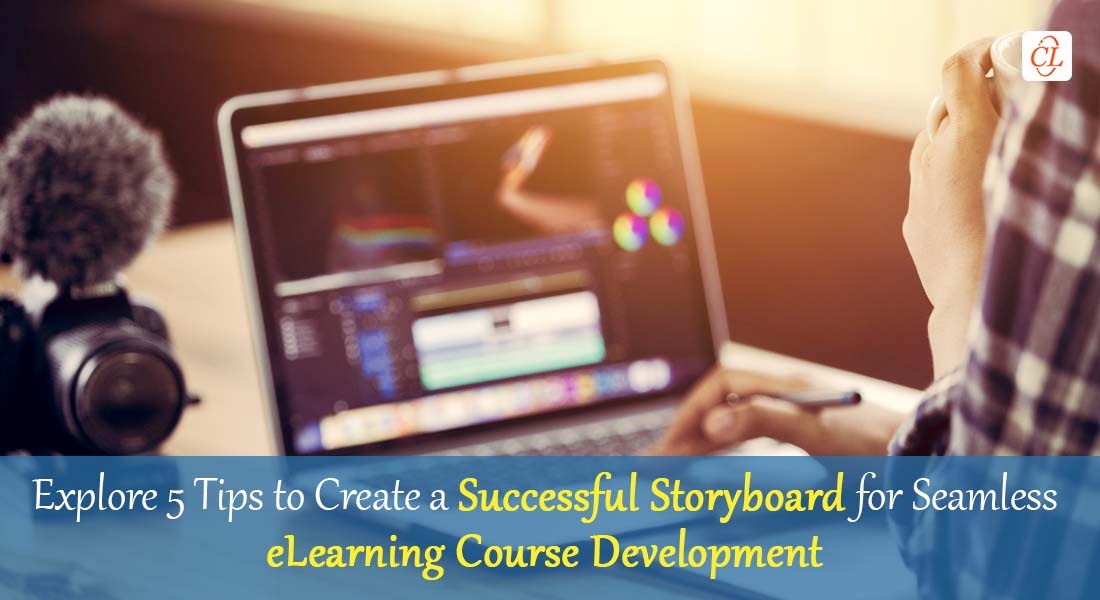How to Design Perfect Storyboards for eLearning Courses — 5 Tips to Master the Art

Quick question. What do you do to reach a destination that’s new to you? Use a roadmap, right? And what do you do to design a perfect eLearning course? Well, the answer is simple. You design a storyboard. Behind every successful eLearning course lies a well-crafted storyboard, serving as the blueprint that guides the entire development process. In this blog, we'll delve into the intricacies of storyboarding for eLearning courses, its significance, and practical tips to master this art.
Keen to Master the Art of Perfect Storyboarding?
Here are 5 quick tips to follow:
- Begin by structuring the flow
- Use templates and tools
- Make the right blend of information and interactivities
- Ensure clear navigation
- Allow room for feedback and iteration
What is Storyboarding in eLearning?
For those who are new to the world of eLearning, storyboarding in eLearning is the process of visually planning the structure, content flow, and interactivity of an eLearning course. It involves creating a sequence of screens or slides that outline the course's content, navigation, interactions, multimedia elements, and assessments. You can design it on a Word document or PowerPoint Slides. It is the framework that provides a glimpse of the final eLearning course.
→ Download Free PowerPoint Templates: Storyboards for Interactive eLearning
Why is Storyboarding Important for Designing eLearning Courses?
Storyboarding holds immense importance in eLearning course design due to several compelling reasons:

1. Provides Scope for Instructional Designers to Present Their Ideas
Storyboarding allows instructional designers to conceptualize and present their ideas visually. It serves as a communication tool that aligns stakeholders' expectations and ensures a clear roadmap for the course development. Your instructional designers can mention details of aspects such as how the narrative flows, what media elements are to be used, and the complexity of the interactivities for the stakeholders to get a bigger picture of the expected output.
2. Revs Up Content Creation Process
By storyboarding, instructional designers can decide on appropriate media elements such as images, videos, or simulations early in the process. This pre-emptive approach helps identify errors, inconsistencies, or gaps in content, leading to a smoother development phase. Moreover, effective collaboration among designers, subject matter experts, and stakeholders is facilitated, enhancing efficiency and reducing rework. This ensures faster turnaround of eLearning courses.
3. Ensures Improved Focus on Learning Objectives
It is quite natural to stray away from the core subject while designing an eLearning course as we get tempted to include all the information available at hand. The mantra is to stick to the “need to know” content and keep the “nice to know” content aside for performance support learning modules. A well-designed storyboard keeps the focus on learning objectives throughout the course development. It helps in structuring content in a way that aligns with the desired learning outcomes, ensuring that learners receive relevant and impactful information.
4. Enables Better Utilization of Budget
Storyboarding helps in estimating the resources required for course development accurately. By visualizing the course structure and content flow beforehand, you can allocate the budget judiciously, avoiding unnecessary expenses and optimizing resource utilization.
5. Facilitates Effective Storytelling
Studies show that information presented in the form of narratives is retained better as compared to dry facts and statistics. Storytelling builds an emotional connection with learners and leaves a mark that’s remembered for a longer hault. Storyboards lay the foundation for effective storytelling in eLearning courses. They enable designers to create narrative arcs, scenarios, and character interactions that engage learners and enhance the retention of information.

How to Get it Right — 5 Amazing Tips for Perfect Storyboarding
Now that we understand the importance of storyboarding, here are five tips to master this art efficiently:
1. Begin by Structuring the Flow
Start by outlining the course structure and defining the learning path. Identify key modules, topics, and subtopics to create a logical flow of content. Consider incorporating interactive elements, assessments, and multimedia at appropriate intervals to enhance engagement.
2. Use Templates and Tools
Utilize eLearning storyboard templates and specialized tools to streamline the storyboarding process. Templates provide a standardized format for organizing content, while tools like digital whiteboards or storyboard software offer features for visualizing, editing, and sharing storyboards collaboratively. Leveraging tools and templates makes storyboarding easy and maintains consistency throughout.
3. Make the Right Blend of Information and Interactivities
Too much information is overwhelming and too many interactivities can hamper actual learning. Strike a balance between informational content and interactive elements. Incorporate scenarios, simulations, quizzes, and branching scenarios to promote active learning and reinforce concepts. Ensure that each screen or slide aligns with the preferences of the target audience and learning objectives, and contributes meaningfully to the learning experiences. Use subtle colors, avoid text-heavy slides, and include visual elements for easy comprehension.
4. Ensure Clear Navigation
Design intuitive navigation paths that allow learners to progress seamlessly through the course. Use menus, buttons, and progress indicators to guide learners and provide them with a sense of control over their learning journey. While storyboarding, provide detailed instructions for each interactivity to leave no room for misinterpretations. Your storyboard must give a clear idea of all elements such as text, hypertext, hyperlinks, and hover text to appear on the screen, for ease of understanding for the eLearning developer.
5. Allow Room for Feedback and Iteration
Include checkpoints in the storyboard where feedback can be gathered from stakeholders, subject matter experts, and potential learners. Iteratively review and revise the storyboard based on feedback to refine the content, interactions, and overall user experience.
Designing eLearning courses is both art and science. This video entails five best practices for effective eLearning design and development. Watch now!
It’s a Wrap!
Storyboarding is the cornerstone of effective eLearning course design, empowering instructional designers to visualize, plan, and create engaging learning experiences. I am sure by implementing the tips discussed, your corporate training initiatives can achieve higher learner engagement, improved learning outcomes, and optimized resource utilization. After all mastering the art of storyboarding is not just about creating courses; it's about crafting immersive learning journeys that resonate with learners and drive performance improvement.
All set to get started? Here's a bonus! Try these free editable PowerPoint templates for quick and easy storyboarding for interactive eLearning experiences.





